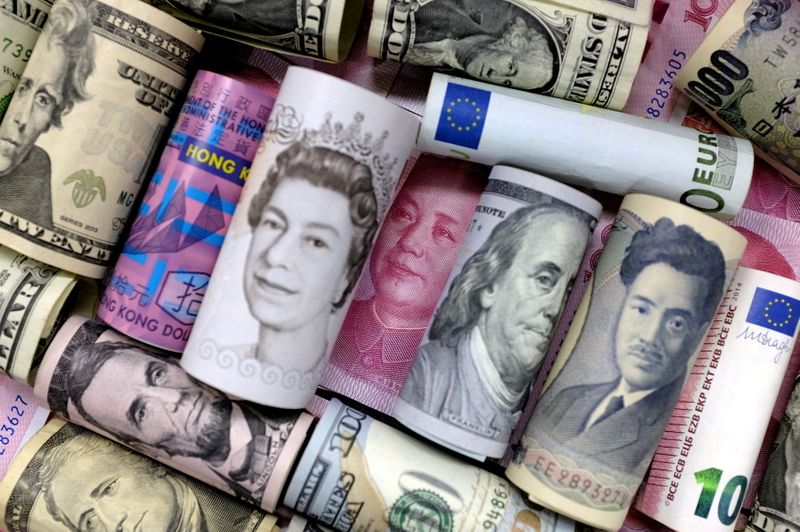By Dhara Ranasinghe
LONDON (Reuters) - U.S. debt ceiling wrangles and the euro's growing dominance of bond issuance linked to environmental or sustainability goals could start to chip away at Treasuries' status as the ultimate reserve asset, putting Europe in a position to boost its share.
The $22 trillion market in U.S. government bonds is the bedrock of the global financial system with unrivalled depth and liquidity. Viewed as a super-safe asset that will never be defaulted on, it underpins the dollar as the world's number one reserve currency.
Except that a default, be it only a short-lived technical one, no longer looks like an impossibility and that could hurt the safe-haven image of Treasuries, analysts and investors say.
As the Treasury bumps up time and again against borrowing limits, the growing polarisation of Congress has in recent years turned what should be a simple vote to raise the debt cap into a series of prolonged crises.
While an October default has recently been averted, deadlock will likely resume with a longer-term solution required by early December..
Which is not to say the dollar is about to be knocked off its pedestal. Reserve status shifts play out over decades and, aside from the ease of trading Treasuries, most global trade is still invoiced in the greenback.
Yet a process may be in train for Treasuries to cede some share to rivals, particularly the euro, with investors and businesses alike warning of the financial damage that stems from treating the debt ceiling as a partisan weapon.
"Each time this kind of thing happens, it incrementally dents international confidence in Treasuries. You can't say the U.S. doesn't lose feathers each time it politicises the debt ceiling issue," said Thomas Costerg, senior economist at Pictet Wealth Management.
Graphic: IMF Q2 foreign exchange reserves - https://fingfx.thomsonreuters.com/gfx/mkt/dwpkragqgvm/IMF0810.PNG
Even a partial erosion of reserve status would impose significant costs on U.S. taxpayers, according to a recent paper by the Brookings Institution.
The paper estimated that the unparalleled safety of Treasuries lowers government borrowing costs by an average 25 basis points relative to other major sovereign issuers. At current debt levels, this translates into interest savings of roughly $60 billion this year, and more than $700 billion over the next decade.
OCEANS RISE, EMPIRES FALL
International Monetary Fund data shows the share of dollar reserves held by central banks fell to a 25-year low of 59% by the end of 2020 and is holding near those levels.
Overall last year, investors sold Treasuries while buying Japanese and German government bonds, Institute of International Finance (IIF) research shows.
Graphic: Foreign flows into Treasuries vs peers, 2009 and 2020 - https://fingfx.thomsonreuters.com/gfx/mkt/movanjmbqpa/IIFDATA0810.PNG
One explanation is that emerging market central banks were forced to sell Treasuries during the pandemic crisis but IIF chief economist Robin Brooks also notes the bonds did not act as the safe-haven they should be during the market meltdown in March 2020 - when a massive selloff pushed yields sharply higher before Federal Reserve intervention stabilised markets.
"What matters – if you are a safe haven asset that Treasuries purport to be – is that you get inflows when times are tough and risk appetite is low," Brooks said. "That didn't happen last year, but it did very noticeably for German Bunds."
EURO GAINER?
The euro makes up a fifth of global currency reserves but has been hindered by the lack of a sizeable "safe" asset. AAA-rated German bonds amount to just 1.6 trillion euros ($1.9 trillion), a tiny amount compared to the $20 trillion plus Treasury market.
Fractious U.S. politics, however, contrast with European cohesion during the COVID crisis and the creation of an 800 billion-euro joint fund has quashed euro zone break-up risk and will increase the pool of AAA-rated euro-denominated assets.
Graphic: The cost of insuring against a debt default, US vs Italy - https://fingfx.thomsonreuters.com/gfx/mkt/lgvdwlmqypo/USIT0810.png
Christian Kopf, CIO for fixed income and FX at Union Investments, said he had been surprised by the demand for euro-denominated assets from Asian clients, especially in South Korea. He noted that the supply of such assets tops 4 trillion euros when including all bonds with a still solid AA- rating and above.
A bigger future selling point may be euro dominance of bonds meeting environmental, social and governance (ESG) criteria, which finance projects benefiting the climate or society.
Almost half of new global green bond issuance was in euros last year, versus 28% in dollars, according to Marcus Pratsch, head of sustainable bonds and finance at DZ Bank.
Such securities are in high demand, with this week's 12 billion-euro European Union green bond flooded with 135 billion euros in orders. The U.S. Treasury is yet to issue green debt.
Central banks are keen for more ESG exposure, a 2019 survey by Morgan Stanley (NYSE:MS) and the IIF found. Japan last week said it would start using its reserves to buy ESG securities.
"The euro will...remain the most-sought currency in the sustainable bond market, further strengthening its international role," Pratsch predicted.
Graphic: ESG bond issuance in US dollars vs euros - https://graphics.reuters.com/GLOBAL-MARKETS/mopanjmoqva/chart.png
